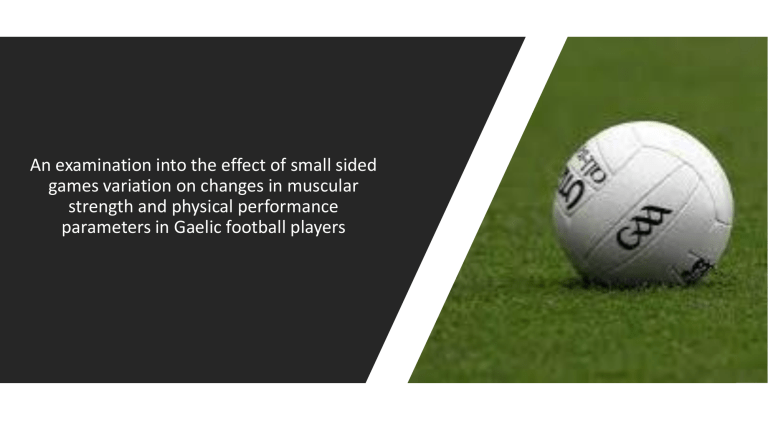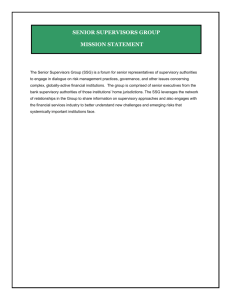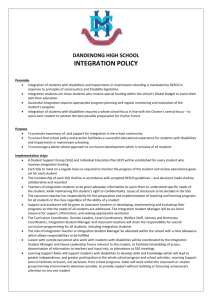
An examination into the effect of small sided games variation on changes in muscular strength and physical performance parameters in Gaelic football players Purpose of the study To evaluate the effect of SSG variation on changes of muscular strength as a measure of induced fatigue, and physical performance parameters within GF. The why? SSG within GF has become a very popular training method because of the aerobic and anaerobic benefits and the large number of technical interaction involved and decision- making scenarios for players; making them highly specific to the game demands.. With SSG there are important implications for training design as fatigue expression is task specific. The literature shows different SSG design changes (size, number of players and rules influences workloads and running performance). A greater understanding on the physiological effects of SSG interventions on muscular fatigue will enable coaches to structure specific training towards competition and help practitioners in game a return to play model for sports injury rehabilitation. Study Design • This statistical analysis will be used to understand the main effect of the format type (SSG - G or SSG P) and the number of players involved (5,7, or 9 a side) on the physical parameters and on muscular fatigue. • SSG G – Games based • SSG P – Possession based The research study proposes to recruit 12 -16 Gaelic football (GF) players. All players will conduct 6-8 sessions over a 4-week period Game Design • SSG consisting of subjects participating in SSG with different pitch dimensions, playing numbers and formats will be performed in a 3-minute continuous game regime for 4 bouts separated by 1-minute rest intervals. • Each drill will be under the supervision, coaching and motivation of several coaches. • In case of the ball being played put of play, an extra ball will always be available for a prompt replacement to ensure game flow is not disrupted. All intervention sessions will be conducted at the same time of day and separated by at least 48 hours. Each team will have an equal distribution of skilled players, which the coaching. • SSG = Small sided game Game Design Continued Each team will have an equal distribution of skilled players, which the coaching staff will determine. Multiple SSGs will be played concurrently to ensure all players are active simultaneously, meaning that additional players from the squad will be included to make up the numbers. Firstly small-sided games played with goalkeeper and regular goals (SSG-G) and then a collective possession only game (SSG-P) will be played where the objective is to keep the ball for longer than the opposing team avoiding turnover Games format. • A total of 4 x 3 minutes bouts of one SSG will be played per session, with two different SSGs formats being played each same week Games Data Collection Hamstring Testing • Intervention protocols and measures 1. Maximal Isometric strength. Maximal voluntary isometric contraction (MVIC) for the hamstring muscle group will be tested on the dominant limb at 90° and 30° knee flexion (KF). • The selection of tests is based on integrated electromyographic activity of biceps femoris musculature being shown to be maximally activated between 15° and 30° of KF, while the semimembranosus and semitendinosus musculature are maximally activated between 90° and 105°. The test will be completed using a Nord bord. Physical Performance • The GPSs attached to the players will provide information about the total distance covered during the game (DT), the maximum speed (Vmax), average speed (V mean), sprint number, sprint distance, and accelerations post baseline testing and pre (post training isometric strength test in each SSG’s different dimensions. The distance covered • in each 1 of the 6 locomotor categories will be provided with the following speed ranges: standing (0–0.5 km/h), walking (0.5–7 km/h), easy running (7– 14 km/h), fast running (14–18 km/h), high-speed running (18–21 km/h), and sprinting (.21 km/h). The actions above 18 km/h (high-speed running and sprinting) will be grouped and defined as high intensity running. In the same way, the GPS devices will register the maximum acceleration peaks and the number of accelerations of the players in different ranges of intensity: 1.2– 2.5 (zone 1), 2.5–3.5 (zone 2), and above.3.5 m/s (zone 3). Small Sided games • An examination into the effect of different (SSG) on physical performance parameter and strength in Gaelic football players Testing Process, benefits and requirements • Are there any benefits from taking part? • The participant may benefit from receiving information and individual feedback from the data collection and the researcher. The information obtained may provide valuable information to the participant in their education towards optimising preparation towards GF and players will also benefit from the improved conditioning and development of energy systems and increased number of technical executions of GF skills being performed in SGG. The interventions are widely supported in current literature particularly in the prescription of SSG as a training intervention in GAA , AFL, and Soccer. • How much time will be needed to take part in the study and the research project? • The total commitment is 10-12 hours. Each participant is asked to arrive 15 minutes early to each training session for the course of the 6 weeks. The testing time and training intervention will last between 25 and 35 minutes each session.



